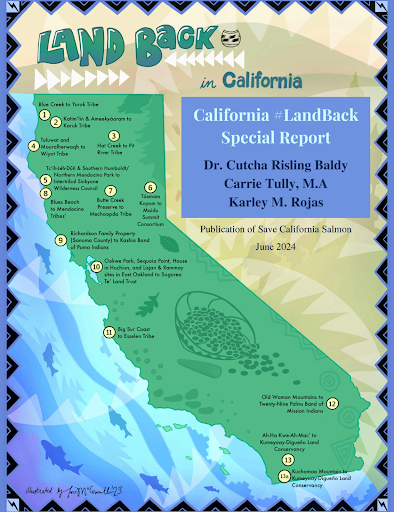Overview
LandBack and Land Acknowledgements

Author: Cutcha Risling Baldy, PhD (Hupa, Yurok, Karuk)
Lesson partner: Humboldt County Office of Education
Grades: 9-12
Suggested Amount of Time: 60 minutes
Curriculum Themes
- History
- Cultural Strengths
- Law/Government
- Relationship to Place
Learning Goals
Understand the role of land acknowledgements and analyze how words and phrases are used to understand the impact of specific word choices.
Analyze the structure of land acknowledgements and practice composing a draft of a land acknowledgement.
Explore the terminology of western expansion and critically analyze how land return can address social problems and domestic policy issues of climate change and climate resiliency in contemporary American society.
Lesson Overview
This lesson plan for high school students (grades 9–12) introduces and critically explores the concepts of land acknowledgements, land dispossession, and the #LandBack movement, with a focus on Indigenous history in California. Beginning with discussions on what land acknowledgements are and why they matter, students are encouraged to research the Indigenous peoples whose land they occupy and to reflect on the significance of recognizing these communities. Through videos, articles, and class discussions, students gain insight into key concepts like Traditional Ecological Knowledge and the 18 unratified treaties of California, developing a deeper understanding of Native sovereignty and environmental stewardship.
Teacher Background
Land Acknowledgements are becoming more popularized at organizations, state agencies and events across the Nation. Generally, these are statements aimed at recognizing and educating about the Indigenous peoples of the region where a group, organization, or event is being held.
The lesson connects historical injustices with contemporary Indigenous resilience. Students learn about California's violent history of Native displacement through maps, primary sources, and examples such as the California Mission system and the Konkow Trail of Tears. These resources expose how settler colonial systems erased Indigenous presence and rights through treaties, systemic violence, and land theft. By examining the legacy of broken treaties and unrecognized tribes, students confront the long-term impacts of colonization and begin to grasp how Indigenous peoples continue to navigate legal and cultural survival.
A key case study highlights the Wiyot Tribe's successful campaign to reclaim Tuluwat Island, demonstrating what land return can look like in practice. This example, alongside a final assignment to create a personal or local land acknowledgement, helps students synthesize the historical and moral significance of these lessons. The unit emphasizes reflection, critical thinking, and respectful engagement with Indigenous voices, aiming to empower students to consider their role in ongoing movements for justice and recognition of Native land rights.

